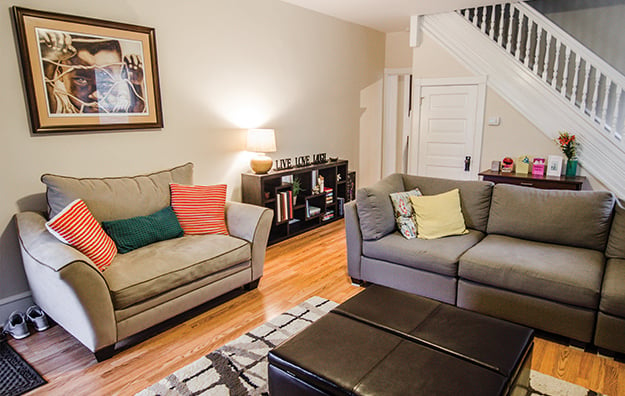The 93-year-old duplex was barely visible from South 7th Avenue in West Reading, hidden behind overgrown arborvitae bushes hovering at the roofline, bamboo choking the side of the property and a crumbling front porch with rotting beams. In stark contrast, the other half of the semi-detached duplex had been purchased and extensively renovated several years earlier.
Bringing It Up to “PARR”
Slipping into disrepair and severe neglect over the last few decades, the weathered and worn half of the duplex finally went onto the market in October of last year. It seemed the perfect opportunity for a new borough program aimed at breathing life back into aging and distressed properties in specific neighborhoods. This home would mark the debut of West Reading’s PARR Program. The Property Acquisition Rehabilitation and Resell program was designed to purchase aging homes, rehab and modernize them, and then list to sell. Basically, a property “flip” – though the idea is to cover renovation and basic rehab costs and not focus on making a large profit.
John Woodward is the owner of the 3rd & Spruce Café in West Reading and a board member of the nine-person West Reading Community Revitalization Foundation (WRCRF) that started the PARR program. He was a key point person in helping secure the home purchase and in overseeing the extensive renovations. He had some mixed feelings about the property initially because of the grand scale of the project.
“I wanted to do the house on South 7th as soon as the PARR project came to fruition. I knew it would have the biggest impact after I saw the other side of the semi-detached house. When I first went in the house, it scared me and I decided it was too overwhelming for our first project. It was a total wreck,” Woodward says of the decrepit interior and poor state of the property.
Inside the deteriorating home, the neglected and overgrown trees made for a dark and dreary interior with little natural light. There were stacks of decades-old magazines piled in the corners, easels and canvases, oil paintings, large mineral samples and other quirky finds throughout the house that told the story of a once prominent fine art curator and artist who lived there. James MK Waldron, his wife Marguerite and their children had at one time owned the entire semi-detached property. He had been the fine art curator at the Reading Museum. After his death in 1974, the property remained in the family.
Investing in the Neighborhood
Dean Rohrbach is the manager of the Elm Street program in West Reading, a program aimed at revitalizing neighborhoods adjacent to main street Penn Avenue. He was instrumental in bringing the PARR program to the borough. He believes it is crucial to focus on housing to improve the landscape of transitional neighborhoods.
Rohrbach said the biggest difference with the West Reading program compared with his previous revitalization experiences in Reading and San Diego is that the PARR program is not funded by taxpayer dollars. Funding for PARR was secured through VIST Bank, The Janssen Foundation, The Wyomissing Foundation, Berks Charitable Foundation and Colonial Oaks Foundation.
Woodward says the private funding is an important aspect of the program. “What people should understand is that we are using private funds that are not encumbered by governmental guidelines that would require us to find homeowners that are below the average median income of the area. We are looking to gentrify West Reading,” he says.
An in-depth market value analysis of the city of Reading and the surrounding area was recently performed and included median sales price, vacant and foreclosed properties and other factors. It mapped out the varying types of neighborhoods and highlighted areas that are transitional or distressed. This analysis is what the PARR program has used to identify those transitional areas in which to focus their efforts.
“The Elm Street areas from 2nd to 7th and from Cherry to Spruce are the target PARR areas and they need the most help,” Rohrbach says of the market value analysis. “If we don’t to something to stabilize and reverse the blighting trend in the transitional neighborhoods, it’s going to spread like a cancer.”
Mayor Shane Keller is the chair of the WRCRF and says the program and the investment gives a lot of bang for the buck.
“Not only does the PARR Program allow us to make an immediate impact in the neighborhoods where these rehab projects occur,” he says, “it also allows us to strategically inject improvements where some of the other Elm Street sponsored projects, such as Paint the Town, may not be a viable rejuvenation solution.”

The Finished Product
The striking 1920s house now sits proudly perched on the hill, restored to its former glory. Unique Victorian Tudor-style architecture, bay windows and an inviting front porch are defining features for this home now that it can be seen from the street. Gone are the overgrown trees, the invasive bamboo and the rotting façade. The home has been painted a complementary color scheme to that of the attached duplex next door.
"That property is among the oldest in West Reading. The architectural style is so different for this area. It's like nothing else of that size," Rohrbach explains of the South 7th home.
The dramatic changes to the home’s interior were done by general contractor Nicholas Gardecki of Berks Custom Remodeling and Restoration. The major overhaul included taking out the vestibule at the front entrance and installing new hardwood floors throughout. The space is flooded with natural light thanks to the pared back landscaping and the removal of invasive trees that blocked the windows. A wall on the first floor was removed to create a more open living space. The once dingy and small kitchen has been transformed into a large, modern one with new cabinets, granite counter tops, tile flooring and an island complementing the new energy-efficient stainless steel appliances.
A laundry room and half-bath were added to the back of the first floor to upgrade the existing layout. The upstairs bathroom was completely remodeled and the second and third floors were carpeted.
All of the home's systems were replaced with energy efficient options: a big improvement from the old oil-burning furnace and outdated electrical work. New plumbing, new windows and a freshly painted interior completed the transformation of the five-bedroom home.
“Our rehab went way beyond just correcting code violations. We brought the property into the 21st century by knocking down walls and opening up the floor plan," says Rohrbach.
In all, the renovations totaled more than $100,000 in addition to the $55,000 purchase price the WRCRF had paid for the home. The home was listed in late spring of 2013 and sold in just 4 days at the full asking price of $164,900.
Nico and Tiffany Carwll are the new owners of the PARR home. Both grew up in Reading and have loved living there with their four children. Despite loving their home and their experience in the city, they began considering a move because of the school district.
“We both love the city and both went to Reading High [RHS]," Tiffany explains. Her husband is now a teacher at RHS.
But the issue of the schools and their desire for a more pedestrian-friendly community started them on a search for a new home. Nearby West Reading seemed the perfect fit.
Initially discouraged by what they were finding, they discovered the home on South 7th online. Tiffany says they loved the pictures of the house on the Internet and thought it would be perfect for their family. In one photo, both she and her husband noticed the PARR program sign in the window of the house. Unaware of the program, they looked it up and read all about the new revitalization program in West Reading. They were hooked.
When they walked through the home just three days after it came on the market, they knew they wanted to make an offer.
“We loved it. We loved it before we walked in,” she gushes of the home.
Now settled in their new home, they’re finding it’s a great fit. Tiffany says the kitchen is a family favorite, as it is with everyone who visits. And with four children ranging in age from 15 years to 3 months, “We have a backyard with enough room for the kids to play and enough bedrooms. Everybody has a room,” she says
And although they love the modern amenities of the remodel, she says they still appreciate the little pieces of the house that once was, like the bay windows and the stained glass transom windows above a few of the interior doors. “Those little things give it character that you can’t get elsewhere.”
Nico and Tiffany consider themselves relatively private people, but said they wanted to share their enthusiasm and support of the PARR program and the progress of revitalization that brought them to their new home. “We want people to see that this is something awesome,” she says of the program.
A Bright Future
The idea is simple, says Rohrbach. By bringing more homeowners to the area and stabilizing the surrounding neighborhoods, liabilities become assets and revitalization progresses.
In turn, this protects the already stable neighborhoods in the borough and protects the progress and improvements already made to Penn Avenue. It’s been just over 10 years since the large scale sidewalk improvement project on Penn Avenue began the revitalization process in West Reading.
Now with the addition of the PARR program, the foundation looks to continue the progress, which is being deemed a success. The WRCRF is already looking to purchase a second PARR property and eventually hopes to complete 3-5 homes per year.
The mayor is equally hopeful. “The goal of the PARR Program is to rejuvenate aging properties while looking to convert multi-family properties back to owner-occupied single family homes where we can,” says Keller. “West Reading is a great community, and the WRCRF is hopeful that programs like PARR will assist West Reading in remaining a great community to live in, work in, and play in.”
The Domino Effect
As one project comes to completion, it gives way to another one beginning.
“We target our investments to connect one strength to another,” Rohrbach explains. “We took the worst property on the block and turned it into an asset. We took an old and cracked public sidewalk and not just replaced it, but added decorative grass and brick medians. That sidewalk happens to connect to our Main Street investment on Penn Avenue. And now that sidewalk leads to a neighborhood with stable homes and real estate on the 100 block of South 7th.”
The PARR program is just another way to secure revitalization for the future in the form of homeowners.
“Homeowners are stake holders,” Rohrbach says. “They are more likely to get involved in the community and more likely to take care of their home. We are trying to attract young families and professionals and people that want to live in a pedestrian-oriented community like West Reading.”
BY REBECCA J. DOUBEK | PHOTOS BY JOHN A. SECOGES, SECOGES PHOTOGRAPHICS















